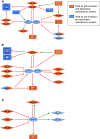EMT-activating transcription factors in cancer: beyond EMT and tumor invasiveness
- PMID: 22945800
- PMCID: PMC11115078
- DOI: 10.1007/s00018-012-1122-2
EMT-activating transcription factors in cancer: beyond EMT and tumor invasiveness
Abstract
Cancer is a complex multistep process involving genetic and epigenetic changes that eventually result in the activation of oncogenic pathways and/or inactivation of tumor suppressor signals. During cancer progression, cancer cells acquire a number of hallmarks that promote tumor growth and invasion. A crucial mechanism by which carcinoma cells enhance their invasive capacity is the dissolution of intercellular adhesions and the acquisition of a more motile mesenchymal phenotype as part of an epithelial-to-mesenchymal transition (EMT). Although many transcription factors can trigger it, the full molecular reprogramming occurring during an EMT is mainly orchestrated by three major groups of transcription factors: the ZEB, Snail and Twist families. Upregulated expression of these EMT-activating transcription factors (EMT-ATFs) promotes tumor invasiveness in cell lines and xenograft mice models and has been associated with poor clinical prognosis in human cancers. Evidence accumulated in the last few years indicates that EMT-ATFs also regulate an expanding set of cancer cell capabilities beyond tumor invasion. Thus, EMT-ATFs have been shown to cooperate in oncogenic transformation, regulate cancer cell stemness, override safeguard programs against cancer like apoptosis and senescence, determine resistance to chemotherapy and promote tumor angiogenesis. This article reviews the expanding portfolio of functions played by EMT-ATFs in cancer progression.
Figures




References
-
- Nieto MA, Cano A. The epithelial-mesenchymal transition under control: Global programs to regulate epithelial plasticity. Semin Cancer Biol. 2012 - PubMed
Publication types
MeSH terms
Substances
LinkOut - more resources
Full Text Sources
Research Materials

